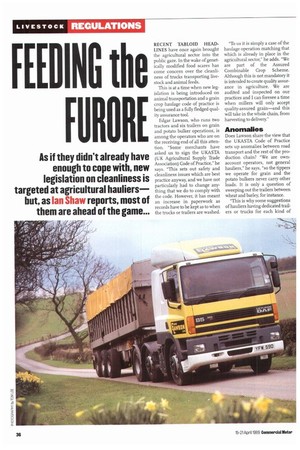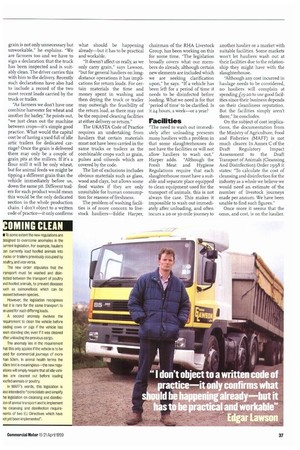FEEDING the FURORE
Page 38

Page 39

If you've noticed an error in this article please click here to report it so we can fix it.
As if they didn't already have enough to cope with, new legislation on cleanliness is targeted at agricultural hauliers
hut, as an Shaw reports, most of
them are ahead of the game...
RECENT TABLOID HEAD. LINES have once again brought the agricultural sector into the public gaze. In the wake of genetically modified food scares has come concern over the cleanliness of trucks transporting livestock and animal feeds.
This is at a time when new legislation is being introduced on animal transportation and a grain crop haulage code of practice is being used as a fully fledged quality assurance tool.
Edgar Lawson, who runs two tractors and six trailers on grain and potato bulker operations, is among the operators who are on the receiving end of all this attention. "Some merchants have asked us to sign the UKASTA ( UK Agricultural Supply Trade Association) Code of Practice," he says. "This sets out safety and cleanliness issues which are best practice anyway, and we have not particularly had to change anything that we do to comply with the code. However, it has meant an increase in paperwork as records have to be kept as to when the trucks or trailers are washed. "To us it is simply a case of the haulage operation matching that which is already in place in the agricultural sector," he adds. "We are part of the Assured Combinable Crop Scheme. Although this is not mandatory it is intended to create quality assurance in agriculture. We are audited and inspected on our practices and I can foresee a time when millers will only accept quality-assured grain—and this will take in the whole chain, from harvesting to delivery."
Anomalies
Does Lawson share the view that the UKASTA Code of Practice sets up anomalies between road transport and the rest of the production chain? "We are ownaccount operators, not general hauliers," he says, "so the tippers we operate for grain and the potato bulkers never carry other loads. It is only a question of sweeping out the trailers between wheat and barley, for instance, "This is why some suggestions of hauliers having dedicated trailers or trucks for each kind of grain is not only unnecessary but unworkable," he explains. "We are farmers too and we have to sign a declaration that the truck has been inspected and is suitably clean. The driver carries this with him to the delivery. Recently such declarations have also had to include a record of the two most recent loads carried by the truck or trailer.
"As farmers we don't have one combine harvester for wheat and another for barley," he points out, "we just clean out the machine between crops—it's simple good practice. What would the capital cost be of having a yard full of idle artic trailers for dedicated carriage? Once the grain is delivered there may only be a couple of grain pits at the millers. If it's a flour mill it will be only wheat, but for animal feeds we might be tipping a different grain than the vehicle immediately before us, down the same pit. Different trailers for each product would mean this would be the only dedicated section in the whole production chain. I don't object to a written code of practice—it only confirms what should be happening already—but it has to be practical and workable.
"It doesn't affect us really, as we only carry grain," says Lawson, "but for general hauliers on longdistance operations it has implications for return loads. For certain materials the time and money spent in washing and then drying the truck or trailer may outweigh the feasibility of the return load, as there may not be the required cleaning facilities at either delivery or return."
The UKASTA Code of Practice requires an undertaking from hauliers that certain materials must not have been carried in the same trucks or trailers as the combinable crops such as grain, pulses and oilseeds which are covered by the code.
The list of exclusions includes obvious materials such as glass, wood and clays, but allows some food wastes if they are only unsuitable for human consumption for reasons of freshness.
The problem of washing facilities is of more concern to livestock hauliers—Eddie Harper, chairman of the RHA Livestock Group, has been working on this for some time. 'The legislation broadly covers what our members do already, although certain new elements are included which we are seeking clarification upon," he says. "If a vehicle has been left for a period of time it needs to be disinfected before loading. What we need is for that 'period of time' to be clarified. Is it 24 hours, a week—or a year?
Facilities
"The need to wash out immediately after unloading presents many hauliers with a problem in that some slaughterhouses do not have the facilities or will not allow hauliers to wash out," Harper adds. "Although the Fresh Meat and Hygiene Regulations require that each slaughterhouse must have a suitable and separate place equipped to clean equipment used for the transport of animals, this is not always the case. This makes it impossible to wash out immediately after unloading, and often incurs a zo or 30-mile journey to
another haulier or a market with suitable facilities. Some markets won't let hauliers wash out at their facilities due to the relationship they might have with the slaughterhouse.
"Although any cost incurred in haulage needs to be considered, no hauliers will complain at spending £i5-zo to use good facilities since their business depends on their cleanliness reputation. But the facilities simply aren't there," he concludes.
On the subject of cost implications, the documentation from the Ministry of Agriculture, Food and Fisheries (MAFF) is not much dearer. In Annex C of the Draft Regulatory Impact Assessment to the Draft Transport of Animals (Cleansing And Disinfection) Order 1998 it states: "To calculate the cost of deansing and disinfection for the industry as a whole we believe we would need an estimate of the number of livestock journeys made per annum. We have been unable to find such figures."
Once more it seems that the onus, and cost, is on the haulier.












































































































